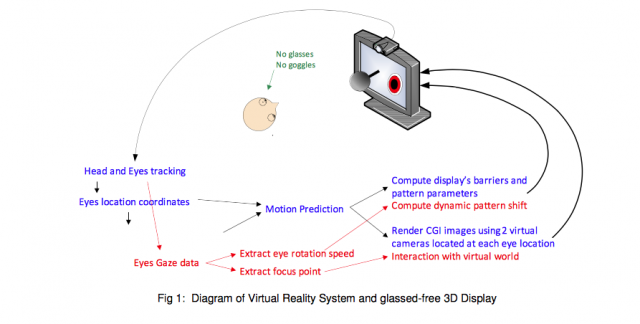 Polarscreens AS 3D Holodisplay using motion prediction and eye gaze dataA second 3D technology also makes use of advanced eye tracking providing full resolution stereo vision without 3D glasses, goggles or other worn apparatus. This comes from Polarscreens Inc.out of Quebec, Canada and the company claims a history in 3D displays since 2003. The advantage of this camera-based eye tracking system is that by tracking the user’s location content can be rendered for the specific user viewpoint, making the display free from eyewear (non-intrusive.) Here’s how: The system provides head and eyes tracking to obtain the eye’s location (co-ordinates) and passes on the gaze data. From this, motion prediction is established using the co-ordinates and exact eye rotation speed and focus point from the gaze data. The motion prediction is used to compute the display’s barriers and pattern parameters, plus render the CGI images from two virtual cameras fixed on each eye location. Rotation speed and focus point of the eyes data is used to compute dynamic pattern shift as well as interaction with the virtual world.
Polarscreens AS 3D Holodisplay using motion prediction and eye gaze dataA second 3D technology also makes use of advanced eye tracking providing full resolution stereo vision without 3D glasses, goggles or other worn apparatus. This comes from Polarscreens Inc.out of Quebec, Canada and the company claims a history in 3D displays since 2003. The advantage of this camera-based eye tracking system is that by tracking the user’s location content can be rendered for the specific user viewpoint, making the display free from eyewear (non-intrusive.) Here’s how: The system provides head and eyes tracking to obtain the eye’s location (co-ordinates) and passes on the gaze data. From this, motion prediction is established using the co-ordinates and exact eye rotation speed and focus point from the gaze data. The motion prediction is used to compute the display’s barriers and pattern parameters, plus render the CGI images from two virtual cameras fixed on each eye location. Rotation speed and focus point of the eyes data is used to compute dynamic pattern shift as well as interaction with the virtual world.
This approach allows adjustment of the stereoscopy axis to the axis of the eyes as to prevent vertical parallax. User gaze is also tracked allowing for other developments like enhancing fixed object sharpness (since the system knows what’s being looked at), while blurring the background to help improve the illusion of a depth of field.
Another advantage is the wide field of vision range that continues from just 6-inches (15cm) to a full 7-feet (2.2M), created by the display layer LCD and a parallel barrier layer created by the patterned backlight. One technique the group uses is to use a series of patterned stripes, made wider than the LCD pixel pitch that helps steer the Rt. and Lt. eye image to the corresponding eye. The Polarscreens paper filed with IZone said information encoding (both 2D and 3D) is done on the display and controlled dynamically. When the eye tracking is disengaged (out of range head tilt for instance, or 2D content displayed), the system switches to 2D mode and content is unaffected by the barrier. This prevents bad stereo, eliminates crosstalk, reverse stereo, vertical parallax and contributes to an overall “comfortable user experience”.
The group said it also worked on a new parallax barrier display technology to counteract the effect of eye rotation during VR sessions using eye tracking and head/motion tracking. This compensates for the “moving gaze” or a rotation of the eyes and eye-head rotation by matching the displayed image with the user’s gaze speed at the appropriate screen depth. Processes include shifting the barrier’s light strip and the video content of each parallax-barrier field. The approach helps compensate for the significant degradation of the image quality when using the glasses-free virtual reality display. The effect is to reconstruct “perfect” images on the user’s retina, allowing users to follow a virtual object, and works when the user looks at a moving object in 3D movies as well.

